Max. PV Input 100V Solar Charge 12V/24V Controller 15A MPPT with LCD
- Loading Port:
- China main port
- Payment Terms:
- TT OR LC
- Min Order Qty:
- 20 unit
- Supply Capability:
- 9999 unit/month
OKorder Service Pledge
OKorder Financial Service
You Might Also Like
Max. PV Input 150V Solar Charge 12V/24V Controller 15A 20A 30A 40A 50A MPPT with LCD
I-P-Wiser 1 series adopted with auto cool, high conversion efficiency, LCD display and free PC software. It features an efficient MPPT control algorithm to track the maximum power point of the PV array in any environment. Greatly improve the utilization of solar panel. Also added the output function(USB 5V 3A). For the mppt controller can be widely used in off-grid solar system, Communication base station solar system, household solar systems, street light solar systems, field monitoring and other fields.
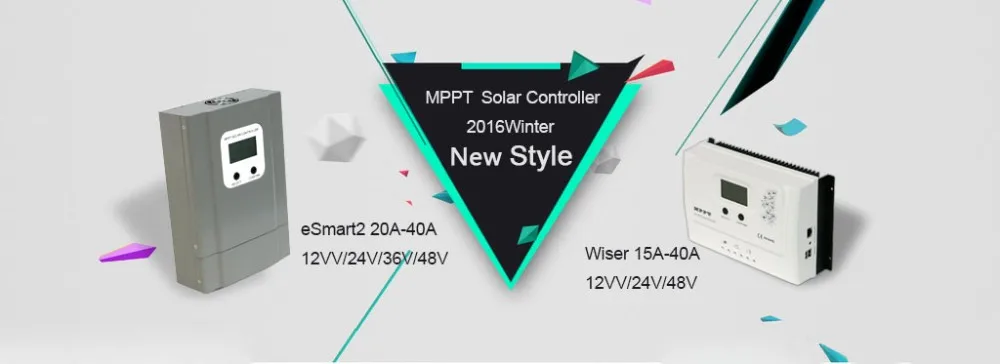
| Product Show |
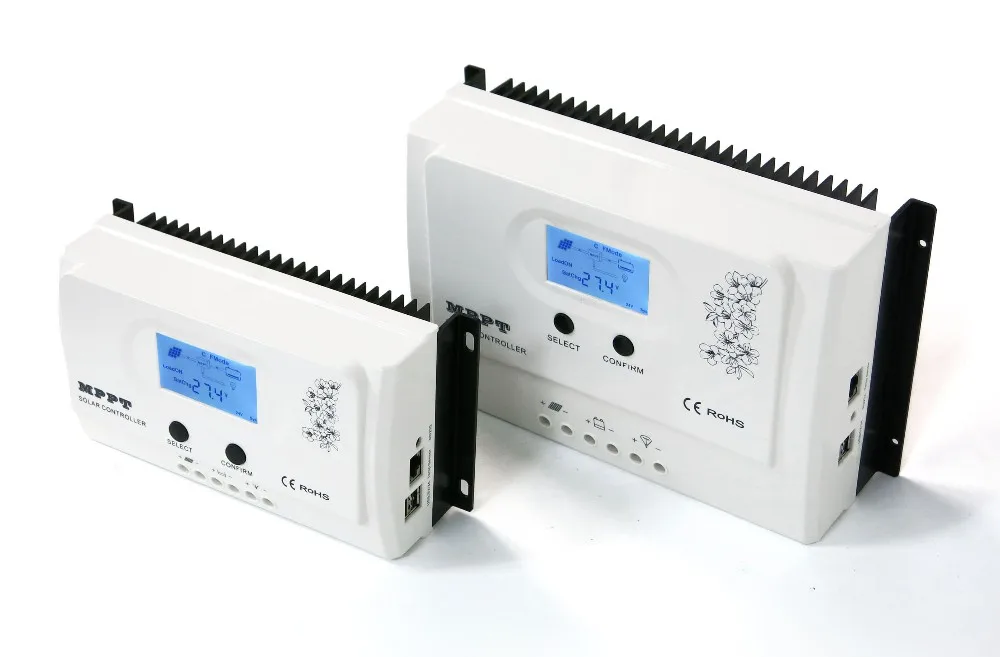
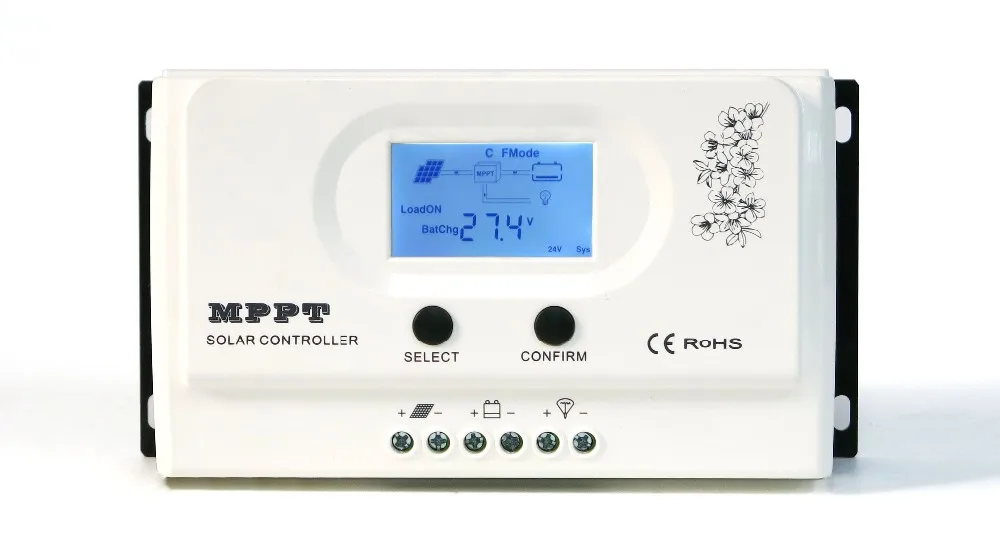
| MPPT Controller connection diagram |
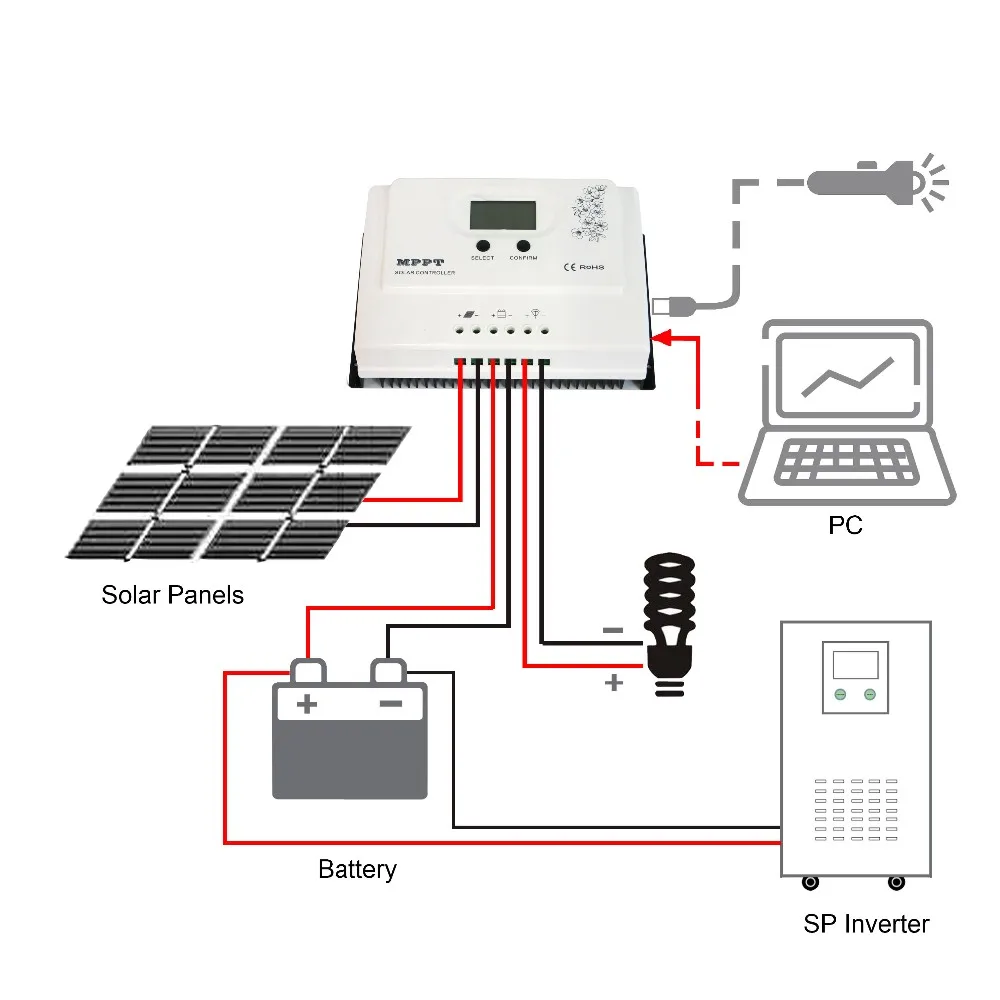
| Features |
1.High efficiency MPPT control algorithm, MPPT efficiency ≥99.5%, whole Machine conversion efficiency upto 98%;
2.12V/24V system Automatic Recognition,users can use it in different system conveniently.
3.Maximum PV input voltage: 100VDC(15A, 20A), 150VDC (30A, 40A,50A)
4.Charge mode: three stages (fast charge, constant charge, floating charge). It prolongs service life of the batteries.
5.Discharge mode: ON/OFF mode, PV voltage control mode.
6.Recommended battery types: sealed lead acid, vented, gel, NiCd battery. Other types of the batteries can also be defined.
7.Most information could be provided by LCD like: system type., PV input voltage, battery type, battery voltage, charging current, charging power, working status and so on. Also customer's information like company name, website and logo can be added into Solar Eagle software.
8.RS232 communication, we can offer communication protocol also, it’s convenient for user’s integration management.
9.CE, RoHS, FCC certifications approved.. We can help clients to approve other certifications.
10.2 years warranty. And 3~10 years extended warranty service also can be provided.
Upper Computer Software and Test Software |
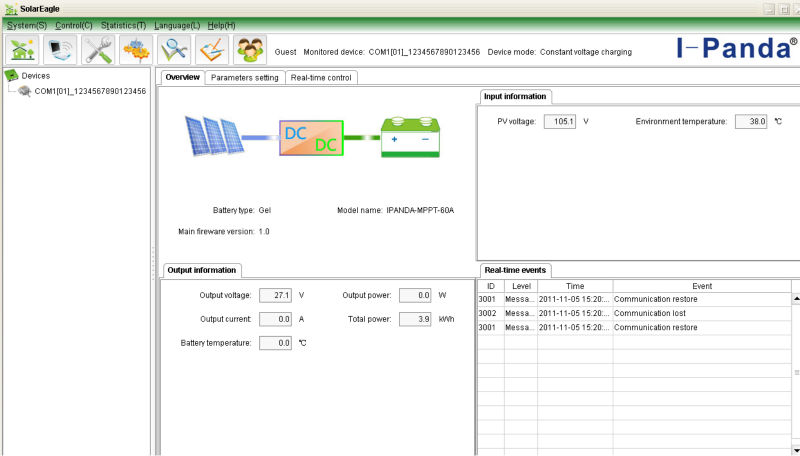
PC software_SolarEagle
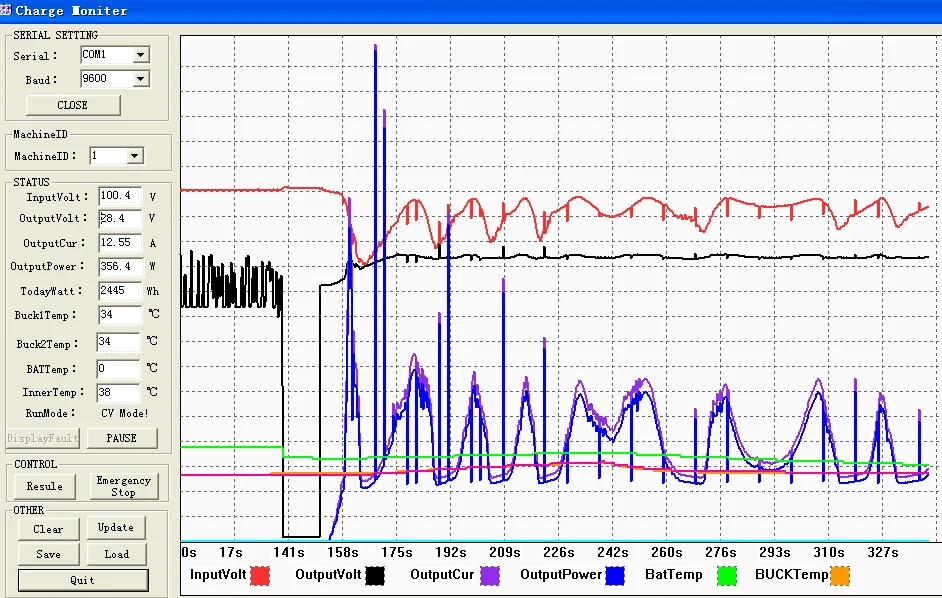
Monitoring software
Visual display of charge and discharge status, PV voltage, charge voltage, charge current, and can set the battery type, LOAD output control;
parameters |
Model: | 15A | 20A | 30A | 40A | 50A | |
I-P-Wiser 1-12V/24V-Series | ||||||
Charge mode | MPPT(maximum power point tracking) | |||||
MPPT efficiency | ≥99.5% | |||||
System type | DC12V/24V system | Automatic Recognition | ||||
INPUT CHARACTERISTICS | ||||||
PV Max PV input voltage(VOC) | 12V/24V system | DC100V | DC150V | |||
Start the charging voltage point | 12V system | 18V | ||||
24V system | 32V | |||||
High input voltage protection point | 12V/24V system | DC100V | DC150V | |||
High input voltage recovery point | 12V/24V system | DC95V | DC145V | |||
Rated PV power | 12V system | 200W | 260W | 390W | 520W | 650W |
24V system | 400W | 520W | 780W | 1040W | 1300W | |
CHARGE CHRECTRESTICS | ||||||
Selectable Battery Types | 12V/24V system | Sealed lead-acid batteries, Vented batteries Gel, NiCd battery (Other types of the batteries also can be defined) | ||||
Charge method | 12V/24V system | Three stages charge: constant current(MPPT), constant voltage, floating charge | ||||
Charge rated current | 12V/24V system | 15A | 20A | 30A | 40A | 50A |
OUTPUT DISCHARGE CHARACTERISTICS | ||||||
USB (Total for 2 USB output) | DC5V 3A | |||||
LOAD output voltage | Based on battery voltage | |||||
Max. DC Load current | 30A | |||||
Output control mode | ON/OFF mode, PV voltage control mode | |||||
Output control set way | Controller button or PC software | |||||
DISPLAY | ||||||
LCD Display | System type, PV voltage,charge voltage, charging current, charging power, temperature etc. | |||||
PC software | RS232 | |||||
OTHER PARAMETERS | ||||||
Protection function | Yes (Over voltage, low voltage, over temperature, over load, Short circuit protection etc.) | |||||
Cooling mode | Auto cool | |||||
Type of Mechanical Protection | IP 30 | |||||
Measurement DxWxH (mm) | 200*110*66 | 243*155*79 | ||||
Packing DxWxH (mm) | 249*144*105 | 289*189*113 | ||||
N.W. (KG) | 0.9 | 1.8 | ||||
G.W. (KG) | 1.3 | 2.2 | ||||
Certifications |
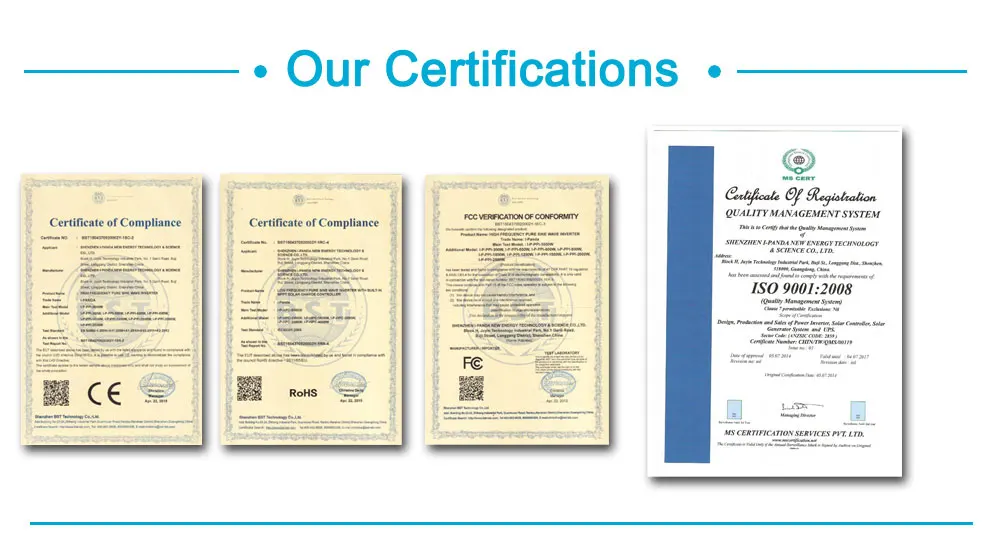
F&Q: |
Q1. How to ensure and monitor the products quality?
A1: We have established a perfect Quality Management System, In strict
accordance with ISO9001: 2008 quality system and ISO14001 environment system for quality assurance management;
Our ISO9001:2008 Quality System certificate encoding: CHIN/TW/QMS/00119;
Our ISO14001 Environment System certificate encoding: CHIN/TW/EMS/00028;
Q2. What is the warranty of products?
A2: The warranty period of different products are different; 5 years, 3 years, 2 years, 1 years; More details please refer to the product specification or manual; we will provide free life-long technical support ;
Q3. What is the difference between MPPT&PWM?
A3. MPPT charging mode, peak efficiency up to 99%, saving 30%~60% solar panel than traditional PWM controller.
- Q:What are the advantages of using a solar controller in a solar system?
- Utilizing a solar controller in a solar system offers multiple benefits: 1. Energy management efficiency: The inclusion of a solar controller allows for effective management of the energy generated by the solar panels. It regulates the electricity flow from the panels to the battery or grid, ensuring optimal system efficiency. 2. Battery safeguarding: Solar controllers prevent battery overcharging and deep discharging. By monitoring battery voltage and current, they ensure optimal charging and protection against damage, extending battery lifespan. 3. System security: Solar controllers safeguard the system against potential electrical faults, such as overvoltage or short circuits, which can harm the panels or other components. This guarantees the overall safety of the solar system. 4. Improved performance in diverse weather conditions: Solar controllers possess built-in features that enable them to adjust charging parameters based on weather conditions. This maximizes solar panel energy output, even in cloudy or low-light conditions. 5. Remote monitoring and control: Many solar controllers offer advanced features like remote monitoring and control. This allows users to conveniently monitor system performance and make necessary adjustments remotely, providing flexibility. 6. Cost-effectiveness: By optimizing the charging process and preventing battery damage, solar controllers reduce maintenance and replacement costs. Additionally, they maximize energy output, resulting in significant savings on electricity bills. In summary, incorporating a solar controller into a solar system yields numerous advantages, including efficient energy management, battery protection, system security, improved performance in diverse weather conditions, remote monitoring and control, and cost-effectiveness.
- Q:Can a solar controller be used in a solar-powered electric motorbike racing system?
- Yes, a solar controller can be used in a solar-powered electric motorbike racing system. A solar controller regulates and optimizes the charging process of the solar panels, ensuring efficient energy transfer to the batteries. In a solar-powered racing system, the solar controller would play a crucial role in managing the energy flow, maximizing the performance and longevity of the batteries, and ultimately enhancing the overall efficiency of the motorbike.
- Q:Can a solar controller be used with solar panels that are connected to a solar air conditioning system?
- Yes, a solar controller can be used with solar panels that are connected to a solar air conditioning system. A solar controller is a device that regulates the flow of electricity from the solar panels to the air conditioning system. It helps optimize the energy generated by the solar panels and ensures that the system operates efficiently. The solar controller monitors the electricity output of the solar panels, controls the charging of batteries (if present), and directs the appropriate amount of power to the air conditioning system. By using a solar controller, the solar panels can be effectively integrated into the solar air conditioning system to maximize energy utilization and reduce reliance on the grid.
- Q:How does a solar controller handle the synchronization of loads?
- A solar controller handles the synchronization of loads by regulating the flow of electricity from the solar panels to the connected loads. It ensures that the power generated by the solar panels is distributed efficiently and evenly among the loads, preventing overloading or underutilization. The controller continuously monitors the voltage and current of the solar panels and adjusts the output accordingly to match the requirements of the loads. This synchronization process helps optimize the performance of the solar system and ensures the smooth operation of the connected devices.
- Q:Can a solar controller be used with solar panel cooling systems?
- Solar panel cooling systems can indeed utilize a solar controller. The solar controller's role encompasses the regulation of power flow from the solar panels to either the batteries or grid. Additionally, it monitors and safeguards the batteries against overcharging or discharging. In the context of solar panel cooling systems, the solar controller can be employed to energize and manage the cooling mechanism. This guarantees that the solar panels maintain ideal temperatures, thereby enhancing their efficiency and lifespan. By employing a solar controller, the cooling system can operate with maximum effectiveness and efficiency, thus optimizing the solar panels' productivity.
- Q:Solar controller water level display is not correct how to do
- Re-adjust the water level to control, choose their own water.
- Q:How does a solar controller handle the monitoring of system performance?
- A solar controller handles the monitoring of system performance by constantly measuring and analyzing key parameters such as solar panel voltage and current, battery voltage and charge/discharge rates, and load consumption. It tracks these data points in real-time and compares them with predefined thresholds or desired targets. If any deviation or anomaly is detected, the solar controller can take corrective actions, such as adjusting charge/discharge rates, activating alarms, or even shutting down the system to prevent damage. Additionally, some advanced solar controllers can provide detailed performance reports and remote monitoring capabilities, allowing users to assess the system's efficiency and troubleshoot any issues.
- Q:How do I calculate the required charging current for a solar controller?
- To calculate the required charging current for a solar controller, you need to consider the battery capacity and the desired charging time. Divide the battery capacity (in ampere-hours) by the desired charging time (in hours) to determine the required charging current (in amperes).
- Q:How does a solar controller handle battery absorption charging?
- A solar controller handles battery absorption charging by regulating the flow of current from the solar panels to the battery. During the absorption charging phase, the controller maintains a constant voltage level, typically around 14.4-14.8 volts, to ensure the battery is charged efficiently without overcharging. Once the battery reaches its maximum charge level, the controller switches to a float charging mode to maintain a lower voltage level and prevent overcharging.
- Q:How does a solar controller handle variations in solar panel temperature?
- A solar controller handles variations in solar panel temperature by monitoring the temperature and adjusting the charging parameters accordingly. This ensures that the battery is charged optimally regardless of the temperature, preventing overcharging or undercharging.
1. Manufacturer Overview |
|
|---|---|
| Location | |
| Year Established | |
| Annual Output Value | |
| Main Markets | |
| Company Certifications | |
2. Manufacturer Certificates |
|
|---|---|
| a) Certification Name | |
| Range | |
| Reference | |
| Validity Period | |
3. Manufacturer Capability |
|
|---|---|
| a)Trade Capacity | |
| Nearest Port | |
| Export Percentage | |
| No.of Employees in Trade Department | |
| Language Spoken: | |
| b)Factory Information | |
| Factory Size: | |
| No. of Production Lines | |
| Contract Manufacturing | |
| Product Price Range | |
Send your message to us
Max. PV Input 100V Solar Charge 12V/24V Controller 15A MPPT with LCD
- Loading Port:
- China main port
- Payment Terms:
- TT OR LC
- Min Order Qty:
- 20 unit
- Supply Capability:
- 9999 unit/month
OKorder Service Pledge
OKorder Financial Service
Similar products
New products
Hot products
Hot Searches
Related keywords






























